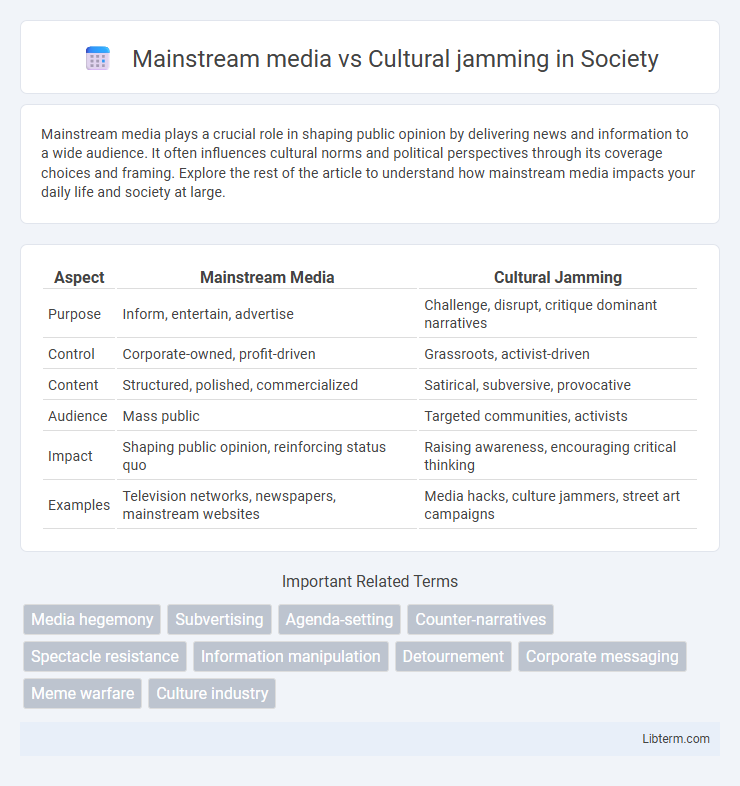Mainstream media plays a crucial role in shaping public opinion by delivering news and information to a wide audience. It often influences cultural norms and political perspectives through its coverage choices and framing. Explore the rest of the article to understand how mainstream media impacts your daily life and society at large.
Table of Comparison
| Aspect | Mainstream Media | Cultural Jamming |
|---|---|---|
| Purpose | Inform, entertain, advertise | Challenge, disrupt, critique dominant narratives |
| Control | Corporate-owned, profit-driven | Grassroots, activist-driven |
| Content | Structured, polished, commercialized | Satirical, subversive, provocative |
| Audience | Mass public | Targeted communities, activists |
| Impact | Shaping public opinion, reinforcing status quo | Raising awareness, encouraging critical thinking |
| Examples | Television networks, newspapers, mainstream websites | Media hacks, culture jammers, street art campaigns |
Understanding Mainstream Media: An Overview
Mainstream media represents established communication channels such as television networks, newspapers, and radio stations that shape public opinion and disseminate widely accepted cultural narratives. It operates under corporate ownership and government regulations, often reflecting dominant ideologies and commercial interests. Understanding mainstream media requires analyzing its role in agenda-setting, framing news stories, and influencing societal values through controlled content distribution.
What is Cultural Jamming?
Cultural jamming is a tactic used to disrupt or challenge mainstream media messages by subverting advertisements and popular symbols to expose hidden agendas or criticize consumer culture. It employs satirical and artistic interventions to provoke critical thinking and raise awareness about social, political, and economic issues often overlooked by dominant media channels. This form of media activism contrasts with mainstream media by aiming to undermine corporate influence and encourage independent, grassroots communication.
Historical Evolution of Mass Media and Culture Jamming
The historical evolution of mass media began with the printing press in the 15th century, expanding through radio, television, and the internet, shaping public perception and cultural norms on a global scale. Cultural jamming emerged in the late 20th century as a form of protest against mainstream media, using tactics like subvertising and media pranks to disrupt dominant corporate messages and challenge consumer culture. This resistance highlights the tension between established media institutions controlling narratives and grassroots movements seeking to reclaim cultural expression and critical discourse.
Tactics and Techniques Used in Culture Jamming
Cultural jamming employs tactics such as subvertising, detournement, and media pranks to disrupt and challenge mainstream media narratives. Techniques include altering advertisements to expose hidden messages, hijacking broadcast signals, and creating viral content that critiques consumerism and corporate influence. This approach leverages irony, parody, and satire to provoke critical awareness and encourage alternative perspectives on dominant cultural messages.
The Power Dynamics: Media Influence vs. Subversive Art
Mainstream media wields significant influence by shaping public opinion and reinforcing dominant cultural narratives through centralized control and widespread dissemination. Cultural jamming disrupts these power dynamics by using subversive art to challenge and deconstruct mainstream messages, exposing underlying biases and encouraging critical thinking. This tension highlights the struggle between institutionalized media power and grassroots resistance in controlling societal discourse and perception.
Representation and Narratives: Who Controls the Story?
Mainstream media dominates representation by shaping narratives through corporate ownership and advertising influence, often promoting prevailing ideologies and limiting diverse voices. Cultural jamming disrupts these controlled stories by subverting media messages and employing satire to expose biases, offering counter-narratives that challenge power structures. The ongoing tension between these forces highlights struggles over who controls public perception and social discourse in contemporary society.
Public Perception: Mainstream Messaging vs. Culture Jamming Impact
Mainstream media often shapes public perception through controlled narratives aligning with corporate or political interests, resulting in widely accepted but potentially homogeneous viewpoints. In contrast, cultural jamming disrupts these dominant messages by exposing contradictions and encouraging critical thinking, fostering alternative perspectives that challenge societal norms. The impact of culture jamming lies in its ability to undermine passive consumption and promote active engagement with media content, thereby influencing public discourse and awareness.
Digital Age: The Rise of Online Culture Jamming
Digital age has transformed cultural jamming into a powerful form of online activism, challenging mainstream media narratives through viral memes, satirical videos, and hashtag campaigns. Platforms like Twitter, Instagram, and TikTok enable rapid dissemination of countercultural messages, amplifying voices that critique corporate control and political propaganda. This digital evolution confronts traditional media gatekeepers by democratizing content creation and promoting participatory culture.
Corporate Interests, Advertisements, and Counter-Messaging
Mainstream media often prioritizes corporate interests by embedding advertisements and promoting content that aligns with the financial goals of major sponsors, reinforcing consumerist values. Cultural jamming disrupts this narrative by using subversive techniques to expose and critique the influence of advertisers and corporations on public discourse. Counter-messaging in cultural jamming reclaims media spaces to challenge dominant commercial ideologies and encourage critical thinking about media consumption.
The Future of Media Resistance and Culture Jamming Movements
Mainstream media often reinforces dominant narratives through controlled content distribution, while cultural jamming subverts these messages by disrupting traditional communication channels to expose underlying power structures. The future of media resistance lies in the expansion of digital culture jamming movements that leverage social media algorithms and decentralized platforms to challenge corporate and political propaganda. Emerging technologies like AI-generated content and participatory media enable new forms of culture jamming, increasing public engagement and transforming media activism into a dynamic force for social change.
Mainstream media Infographic

 libterm.com
libterm.com